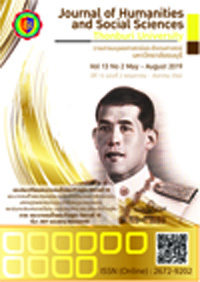MULTIPLE-PARALLEL MEDIATOR INFLUENCE OF CORPORATE IMAGE AND CUSTOMER SATISFACTION TRANSFERRING SERVICE QUALITY TO PURCHASE INTENTION BEHAVIORS OF KRUNGTHAI BANK PCL’S CUSTOMERS
Keywords:
Service Quality, Corporate Image, Customer Satisfaction, Purchase Intention Behaviors of CustomerAbstract
The objectives of this research are to (1) study the service quality, corporate image, customer satisfaction and purchase intention behaviors, and (2) study the multiple-parallel mediator influence of corporate image and purchase intention behaviors which transfers the service quality to purchase intention behaviors of Krungthai Bank PCL’s customers. Sample group used in the research is 500 Krungthai Bank PCL’s customers based on the concept of Comrey and Lee (2013). Statistical method conducted in this research consists of (1) the descriptive statistics (mean value) and (2) the analyzed statistics of structural equation model (SEM) via PLS Graph 3.0 program.
As results, it was found that the maximum average value of customer satisfaction is of 4.057 and the standard deviation value is of .709. The second is the purchase intention behaviors with the average value of 4.018 and the standard deviation value of .811. For the service quality, the average value is of 3.996 and the standard deviation value is of .528. For the corporate Image, the average value is of 3.989 and the standard deviation value is of .795. From analysis results, it was noticed that the multiple-parallel mediator influence of corporate image and customer satisfaction effect the quality factor transformation to purchase intention behaviors of Krungthai Bank PCL’s customers, significantly.
References
มนตรี พิริยะกุล. (2558). ตัวแปรคั่นกลางและการทดสอบอิทธิพลทางอ้อม. วารสารการจัดการและการพัฒนา. 2(1): 11-30.
Aaker, D. A. (1991). Managing brand equity: Capitalizing on the value of a brand name. New York: The Free Press.
________. (1996). Measuring brand equity across products and markets. California Management Review. 38(3): 103.
Aaker, D. A., & Joachimathater, E. (2000). Brand leadership. New York: The Free Press.
Abrahams, D., & Granof, E. (2002). Respecting brand risk. Risk Management. 49(4): 40-45.
Bitner, M. J. (1992). Servicescapes: The impact of physical surroundings on customers and employees. The Journal of Marketing, 57-71.
Chin. (2001). from http://www. Pubinfo.vcu.edu/carma/documents.
Cobb-Walgren, C. J., Ruble, C. A., & Donthu, N. (1995). Brand equity, brand preference, and purchase intent. Journal of Advertising. 24(3): 25-41.
Comrey, A. L., & Lee, H. B. (2013). A first course in factor analysis. Psychology Press.
Cubillo, J. M., Sanchez, J., & Cervino, J. (2006). International student’s decision-making process. International Journal of Educational Management. 20(2): 101-115.
Dennard, R. H., & Wong, H. S. P. (2000). U.S. Patent No. 6,020,581. Washington, DC: U.S. Patent and Trademark Office.
Hardin, J., & Keller, R. (1988). The behavior and function of bottle cells during gastrulation of Xenopus laevis Development. 103(1): 211-230.
Kazoleas, D., Kim, Y., & Anne Moffitt, M. (2001). Institutional image: A case study. Corporate Communications: An International Journal. 6(4): 205-216.
Knapp, D. E. (2000). The brand mindset. New York: McGraw-Hill.
Kotler, P., & Keller, K. L. (2006). Marketing management. 12thed. Upper Saddle River, NJ: Prentice Hall.
Kuo, C.-W., & Tang, M.-L. (2011). Relationships among service quality, corporate image, customer satisfaction, and behavioral intention for the elderly in high speed rail services. Journal of Advanced Transportation. 10: 1-13.
Mohamed, E. A., & Nahas, T. E. (2013). The impact of corporate image and reputation on service quality, customer satisfaction and customer loyalty: Testing the mediating role. Case analysis in and international service company. The Business & Management Review. 3(2): 177-196.
Nishii, L. H., Lepak, D. P., & Schneider, B. (2008). Employee attributions of the why of HR practices: Their effects on employee attitudes and behaviors and customer satisfaction. Personnel Psychology. 31: 503-545.
Omotayo, O.; & Joachim, A. A. (2008). Customer service in the retention of mobile phone: Users in Nigeria. African Journal of Business Management. 2(2): 26-31.
Rahman, M. S. (2012). Service quality, corporate image and customer’s satisfaction towards customers perception: An exploratory study on telecom customers in Bangladesh. Business Intelligence Journal. 5(1): 59-63.
Rust, R. T., & Zahorik, A. J. (1993). Customer satisfaction, customer retention, and market share. Journal of retailing. 69(2): 193-215.
Slatten, T. (2008). Antecedents and effects of emotional satisfaction on employee-perceived service quality. Managing Service Quality. 3(4): 370-386.
Temple, P. (2006). Branding higher education: Illusion or reality, perspective. Policy & Practice in Higher Education, 10, 15-19.
Van Riel, Cees, B. M., & Berens, G. (2004). Corporate associations is the academic literature: Three main streams of thought in the reputation measurement literature. Corporate Reputation Review. 7(2): 161-178.
Wan, H. L. (2007). Human capital development policies: Enhancing employees’ satisfaction. Journal of European Industrial Training. 31(4): 297-322.
Weiwei, T. (2007). Impact of corporate image and corporate reputation on customer loyalty: A review. Management Science and Engineering. 1(2): 57-62.
Translated Thai References
Piriyakul, Montree. (2015). Mediators and Tests of Indirect Effect. Journal of Management and Development, Ubonratchathani Rajabhat University. 2(1): 11-30. (in Thai)
Yoshida, D., Thalang , C. N., Pomsuwan, S.; & Tungbenchasirikul, S. (2018). Expectation and Satisfaction Towards the Travel in Thailand of Japanese Elderly Tourists. Journal of Humanities and Social Sciences Thonburi University. 12(Special Edition): 127-137. (in Thai)







